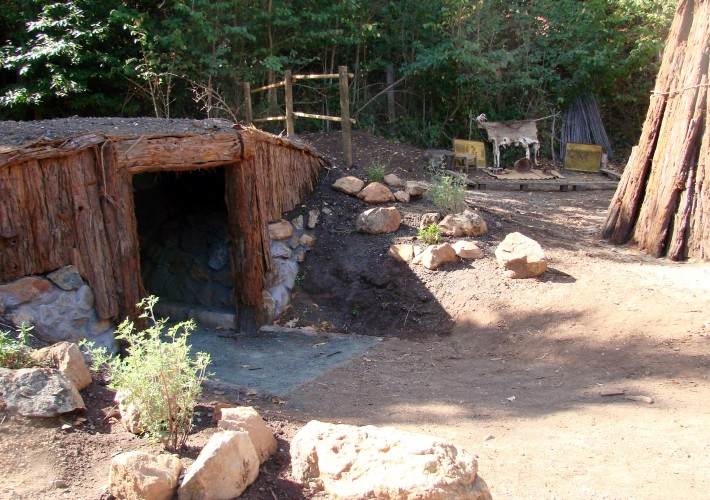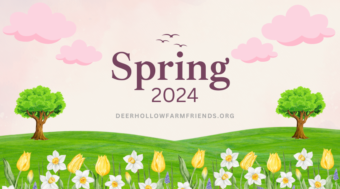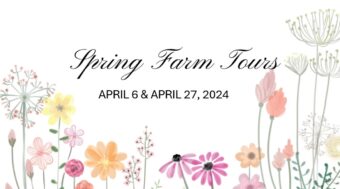Here’s a detailed list of Ohlone activities that are on display at our Ohlone Village during our annual Ohlone Day or during classroom visits.
Flintnapping
Flintnapping was the domain of men. In this area obsidian was the most commonly used material. The rock would be flaked or “napped” for spearheads. Obsidian was not found in this area (it is found in volcanic regions in northern and eastern California) so the Ohlone had to trade for their arrowhead materials. Spears were used until bow and arrows were introduced approximately 900 years ago.
Sweat House
The men’s sweat house was used to prepare for a hunt. They would rid their bodies of odor so the prey could not smell them and pray to the animal gods for a good hunt. They would fast and stay in the sweat house for as long as three days and nights. Hunting tactics would be discussed. When done, they would jump in water and clean off before rubbing themselves with bay leaves and mud to disguise their smell and keep insects off.
Shell Drilling and Bead Making
Beads were valuable in trading and were virtual money to the Ohlone. They were also prized as decoration and served in some tribes as an indication of wealth. The Indians twirled a stick with a chert bit, we call it a pump drill, to create holes in shells.
Face Painting
The Ohlone used mud as face and body paint as decoration for celebrations. Other California tribes used the paint made by grinding soft colored rocks against harder rocks.
Basketry
Women made baskets and men made snares and traps. Baskets were designed for gathering acorns, berries, bulbs and water and traps for fishing and catching birds. Fine willow branches were used to make acorn gathering baskets while tule grass was used for berry and bulb baskets. The digging stick was used to dig roots for coiled basket making and bulbs for eating. Sedge root, bracken fern root, and redbud were all used to make coiled cooking baskets.
Other Tool Sources
Animal bones were used for spear heads, knives, awls and needles. Deer antlers were used in weapon making. Tule grass, which grew in the Bay, made fishing boats, duck decoys, hats, and toys.
Cordage
String was used to make structures and tools. Plant material used included wild iris, stinging nettle, milkweed, dogbane and tule grass. Other types of cordage included sinew from a deer’s leg which was used in weapon making and strips of deer hide.
Granary
Nuts took two to six weeks to dry. A granary had small door and was thickly covered with tule mats to keep out the rain and foraging animals.
Acorn Preparation
Ohlone women spent a few hours each day processing acorns. The harvest of nuts was done in the autumn and stored in the granaries. They used a mortar and pestle to pound the nut into flour. Acorn flour was leached in a sand pit near water to get rid of the tannic acid. In the years there were poor acorn harvests, they used the buckeye nut which required a longer leach time to eliminate the prussic acid.
Fire Making/Cooking Acorn Mush
An ember was created from the friction created by using one’s hands to turn a stick of soft wood, usually elderberry, upon a hardwood hearth board, usually buckeye or oak. The ember was transferred to a tinder nest. Natural items that can be used as tinder are the fluffy seed attachments of cattail, wild clematis, dandelion, thistle and coyote bush. Cooking was women’s work. A smooth fist-sized rock is placed in the fire, two sticks (used as tongs) lifts it, rinses it, and puts it in a cooking basket while a spoon made from willow stirs it to keep from burning the basket. The heat from the rock cooks the acorn mush. Large shells were used as spoons, bowls and cups.
Yerba Buena Tea
Yerba Buena is a type of mint and the tea was good for stomach aches and colds. Pounded leaves were applied to wounds and sores.
Food and Village Life
Everyone was involved in procuring or preparing food. Girls assisted with gathering and boys with hunting. Because the giving of life was woman’s most important role, she did not participate in the taking of life, which included coming in contact with weapons.
Sleeping House
The frame is composed of thick willow branches creating a dome structure which was then covered with mats of tule grass. Bark ties were used to assemble the willow frame. Animal pelts were used to keep warm. This was a family structure and besides sleeping here, it is where they kept their most valuable possessions such as baskets, pelts, and shells. The exception was weapons which were kept in the sweat house.
Kotca
The Ohlone who lived in the Santa Cruz Mountains and near the coast had easy access to redwood trees. They built their sleeping houses by leaning redwood bark against poles tied together.
Music Circle in Round House
The round house was used by everyone in the village and was a gathering place for ceremonies, music, singing, dancing and contemplation. It would have been constructed like a sleeping house, but larger. The Ohlone musical instruments were elderberry clapper sticks; deer hoof rattles, whistles made from bird wing and leg bones as well as flutes of elderberry. The Shaman would have used the Bull Roarer.
Clothing
A female would wear a deerskin skirt and a tule grass apron; plain for everyday wear and well decorated for ceremonial wear. Shell jewelry might also be worn. Tattoos of her family lineage would be on her face and shoulders. Since they had no written language, men read a woman’s face to see her family history before marrying. A male would generally wear nothing except for protection against the environment or for ceremonies.
Hoop and Spear Game
Ohlone boys & girls used sticks and hoops to play a hunting game.
Gambling Games
Games were played for entertainment and for valuable stakes such as baskets, pelts or shells. Staves was a simple game which consisted of throwing split elderberry branches and how they landed determined who won. It is similar to throwing dice. The Nut and Stone game was played with marked nuts, the rounder the better, which were then rolled towards a center rock. It is similar to the game of marbles where the object is to get close to, but not touch, the center rock.





